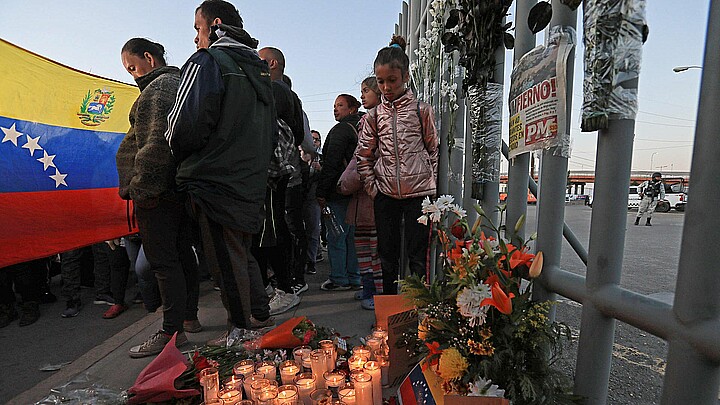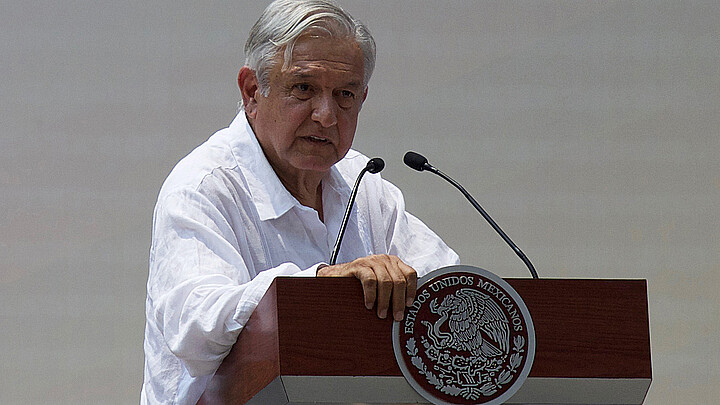Human Rights
Padlocked doors, poor conditions contradict Mexican president's narrative migrants started facility fire
According to local human rights organization who have been monitoring the burned facility, doors were padlocked and migrants were stripped of their property leaving them little opportunity to start a fire—or escape

March 29, 2023 9:15am
Updated: March 29, 2023 9:20am
As details continue to emerge from a Mexican migrant detention facility fire that erupted Monday night, area human rights organizations familiar with the building that casualties screamed for help behind padlocked doors, contradicting the original narrative of Mexican President Andrés Manuel López Obrador who suggested the migrants started the fire themselves to protest deportations.
The new information raises new questions about what really happened to the migrants who were killed and the candor of the Mexican president and an immigration system that some say is holding migrants against their will in dangerous conditions.
If the new information is true, it could mean that the Mexican president embellished details about an ongoing investigation, gaslighting the media with details that cast aspersions on the victims who perished.
To date, authorities have confirmed that at least 40 people died in the fire that broke out inside Estancia Provisional de Ciudad Juárez, where the migrants were being held while awaiting news on their U.S. asylum applications.
While the facility purportedly has a normal capacity of only 60 people, at least 68 people were killed and wounded as a result of the fire, according to Blanca Navarrete, the director of the locally based Comprehensive Human Rights in Action group. Navarrete has also said an estimated 12 females were also processed into the facility just before the fire started.
While the fire has brought great alarm and sadness throughout Mexico, human rights advocates said that migrant facility overcrowding is becoming commonplace.
“We’ve been working hard to limit this detention, because this is exactly the kind of thing that happens,” said Gretchen Kuhner, director of the Mexico-based group Women in Migration, according to a report published by NBC Latino.
“The Mexican government tries to call them other things, but people are detained there, under lock and key, and they cannot leave... I’ve been here for 25 years in Mexico, and we’ve been working on the sickening cases that we have.”
Authorities are currently reviewing a 30-second video that was posted from within the center on Facebook by an area organization that helps in emergencies. The video depicts the fire blazing out of control as one individual stuck behind bars began kicking a padlock, hoping to break it. Two sentries are depicted in front of the locked door, but seemingly incapable of taking action.
Kuhner said the second floor of the immigration processing facility was used as a jail, and suggested that the Mexican government was using some outdated facilities for both migrants and prisoners, a problem some human rights groups have been raising for two decades.
“They should have limits on the number of people who can be locked up, and they’re supposed to have protocols,” she said, according to NBC.
While local civil society and human rights groups have tried gaining access to the facilities to inspect them, Mexican authorities have effectively kept the activists out, leaving the conditions somewhat of a mystery.
“This is a huge issue in Mexico that civil society organizations are not allowed in migration stations, and it’s very difficult for people that are not authorized by the INM to enter into these facilities, which means they’re kind of black boxes,” said Rachel Schmidtke, a senior advocate for Latin America at Refugees International of the country’s National Migration Institute.
According to NBC Latino, Blanca Navarrete, of the Comprehensive Human Rights in Action group said the information they have has suggested that men and women are separated into different areas, and that “all doors have padlocks.”
The report added that Navarrete said the center lacks medical personnel.
Mexico’s treatment of migrants has become an highly controversial issue in the media to the extent it is even being tackled by the country’s judiciary.
On March 15, the Mexican Supreme Court ruled that some of the nation’s migrant detention laws were unconstitutional.
Mexican President Andrés Manuel López Obrador originally stated that said the blaze was ignited by migrants who were lashing out against possible deportations, and reports suggested they may have come from Venezuela.
Human rights organizations are questioning his assertions however, based on the conditions of that facility and others and the fact that the migrants are reportedly stripped of much of their property when they enter.
“What we know so far is that migrants from Central America and some from Venezuela were in that shelter,” the Mexican president said to reporters shortly after the fire broke out.
“We still do not know exactly the names and nationalities of those who unfortunately lost their lives. This had to do with a protest they started after, we assume, they found out they were going to be deported, and as a protest, they put mattresses from the shelter at the door of the shelter, and they set fire to them and they did not imagine that this was going to cause this terrible accident. It is a very sad thing that is happening.”
According to NBC Latino’s report, some area experts, such as Emilio López, a researcher at the Autonomous University of Chihuahua, are contradicting that narrative.
“It is a situation that remains under discussion because the people admitted are searched and stripped of belonging and artifacts that could [cause them harm]” he said. “That is, how did they start a fire if they even took the laces out of their shoes?”
López added that he felt regardless of the intent, the fire signified a human rights violation under the doctrine of negligence.











